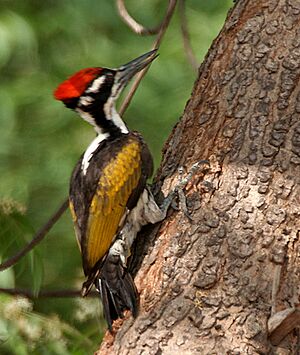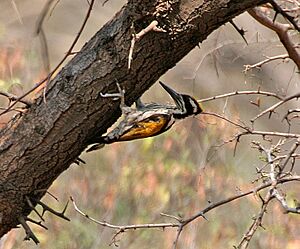White-naped woodpecker facts for kids
Quick facts for kids White-naped woodpecker |
|
|---|---|
 |
|
| Male in Hyderabad, India | |
| Conservation status | |
| Scientific classification | |
| Genus: |
Chrysocolaptes
|
| Species: |
festivus
|
The white-naped woodpecker (Chrysocolaptes festivus) is a type of woodpecker. You can find it in many parts of the Indian Subcontinent, but it's not very common. This bird likes to live in open forests and bushy areas that have some trees. It builds its nest in a tree hole and usually lays one or two white eggs.
Contents
What is a White-Naped Woodpecker?
The white-naped woodpecker is a fairly large bird, growing to about 29 centimeters (that's almost 11.5 inches) long. It looks like a typical woodpecker, with a strong, pointed beak and a stiff tail that helps it lean against tree trunks. Like other woodpeckers, it has special feet called "zygodactyl" feet. This means two of its toes point forward and two point backward, which helps it grip trees. It also has a long tongue that can shoot out to catch insects.
How to Identify a White-Naped Woodpecker
This bird has some unique markings that make it easy to spot:
- Its neck is white at the back, and this white color goes down its back.
- It has black patches on its shoulders that continue onto its back, forming a "V" shape around the white.
- The rest of its upper body and wings are a bright golden yellow.
- Its rump (the area above its tail) and tail are black.
- Its belly and chest are white with dark, V-shaped patterns.
- Its head is mostly whitish, with a dark stripe that looks like a mustache and a black patch around its eye. This black patch goes down the sides of its neck.
Male vs. Female Woodpeckers
You can tell the difference between a male and female white-naped woodpecker by looking at their heads:
- Adult males have a bright red crown (the top of their head).
- Adult females have a yellow crown.
- Young birds look similar to the female, but their colors are not as bright.
Where Does the White-Naped Woodpecker Live?
The white-naped woodpecker is found in two main areas, which are home to its two different types, called subspecies:
- Central and South India: This is where the C. f. festivus subspecies lives.
- Sri Lanka: This is where the C. f. tantus subspecies lives.
How Did the White-Naped Woodpecker Get Its Name?
The white-naped woodpecker was first described by a French scientist named Georges-Louis Leclerc, Comte de Buffon in 1780. He wrote about it in his book Histoire Naturelle des Oiseaux after seeing a bird from Goa, India.
Later, in 1783, a Dutch scientist named Pieter Boddaert gave it the scientific name Picus festivus. The bird is now part of a group of woodpeckers called Chrysocolaptes. This name was given by an English scientist named Edward Blyth in 1843.
Meaning of Its Scientific Name
- The first part of its scientific name, Chrysocolaptes, comes from two old Greek words: khrusos, which means "gold," and kolaptēs, which means "chiseller." This name fits well because of the bird's golden color and how woodpeckers "chisel" into trees.
- The second part, festivus, is a Latin word that means "festive" or "cheerful."



